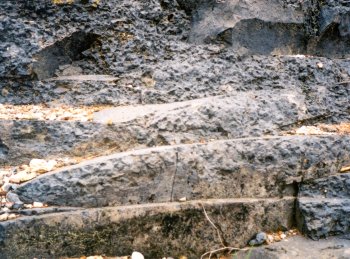Location 5.
St. Thibéry
Further down the road from locality 4. As you walk further down you can actually put you finger on the point where the agglomerate passes upwards into a lava flow.
Outcrop 5.
At this outcrop we see "beds" which have a slight convex-upwards curve to their surface. These "beds" also thin out at their edges and are surrounded by lots of other beds doing the same thing. It is possible to identify these beds as sheet pahoehoe. This means that they are lobes (tongues) of magma which have been released from the vent in a pulsing manner.
Picture 5:
 |
This picture shows outcrop 5. Click on the image to enlarge |
Within these lobes it is possible to identify peridotite nodules. This suggests a rapid ascent of magma to the Earth's surface.
Age:
These lavas have been dated by the K-Ar method to 680,000 ± 100,000 years BP (before present) or younger (Brousse & Lefevre, 1990).
Now proceed to Location 6 or back to Location 4.
Back to main page.